Cafes generate tons of waste daily. Plastic cups, lids, stirrers pile up. Want sustainable solutions that attract eco-conscious customers and reduce your footprint?
Yes, switching to eco-friendly accessories like biodegradable cups, compostable utensils, and recyclable sleeves significantly boosts a cafe’s sustainability. It reduces landfill waste and appeals to green consumers.
Running a cafe is tough, I get it. You’re juggling quality, service, and costs. But what if I told you that going green isn’t just good for the planet, but also great for your business? I’ve seen it happen! We at Ecosourcecn help businesses like yours make this switch smoothly. It’s not about grand gestures overnight, but smart, impactful changes. Let’s explore how these small changes can make a massive difference to your cafe and our world.
Environmental Impact of Traditional Supplies: Just How Bad Is It?
Traditional coffee supplies create mountains of waste daily. Feeling overwhelmed by the plastic problem? Let’s face the not-so-pretty truth and see why change is crucial.
Traditional supplies, mostly single-use plastics, contribute massively to landfill, pollution, and microplastic contamination. They’re derived from fossil fuels, harming ecosystems and human health. A serious issue!
Honestly, when you stop and think about the sheer volume of single-use items a busy cafe goes through, it’s staggering. I remember visiting a local coffee spot – great coffee, terrible waste. Piles of plastic. It really hit home. This isn’t just an eyesore; it’s a deep environmental wound. At Ecosourcecn, we often start conversations with clients like Jacky by looking at these impacts, because understanding the "why" makes the "how" (switching to eco-options) so much more compelling. It’s not about guilt; it’s about awareness and positive action.
The Plastic Problem: A Closer Look
So, what are we really talking about here? Most traditional coffee cups are lined with polyethylene (PE), a plastic, to make them waterproof. Lids are often polystyrene (PS) or polypropylene (PP). Stirrers and straws? More plastic. These materials are derived from fossil fuels, a non-renewable resource. And the term "single-use" is key – they’re designed to be thrown away after just a few minutes. I once read a report stating that a single plastic cup can take up to 500 years to decompose! And even then, it just breaks down into microplastics, which are now found everywhere – in our oceans, our soil, even our bodies. Scary stuff, right? That’s not even mentioning the energy and resources consumed in producing these items in the first place. It’s a massive carbon footprint for something so fleeting.
Beyond the Landfill: Wider Consequences
| The impact doesn’t stop at the landfill. These plastics often find their way into rivers and oceans, harming marine life. I participated in a beach cleanup last year, and the amount of plastic coffee lids and stirrers we found was just depressing. Then there’s the issue of resource depletion – continually extracting fossil fuels isn’t sustainable. Plus, some plastics can leach chemicals, especially when in contact with hot liquids. Think about BPA or phthalates – not exactly things you want with your morning latte. Here’s a quick comparison to put it into perspective: | Item | Material (Traditional) | Est. Decomposition Time | Material (Eco-Friendly) | Est. Decomposition Time |
|---|---|---|---|---|---|
| Coffee Cup | PE-lined Paper/Plastic | 50-500+ years | PLA-lined Paper/Bagasse | 3-6 months (industrial comp.) | |
| Lid | Polystyrene (PS) | 500+ years | CPLA/Bagasse/Paper | 3-6 months (industrial comp.) | |
| Stirrer | Plastic (PS/PP) | 200-500+ years | Wood/Bamboo | 2-6 months (home/ind. comp.) | |
| Straw | Plastic (PP) | 200+ years | Paper/PLA/Hay/Bamboo | Days-6 months (varies) |
Seeing these numbers, it’s clear why we need a change. It’s not just about looking good; it’s about doing good.
Biodegradable Cups and Lids: The Foundation of Green Coffee Service?
Tired of seeing plastic cups pile up? Switching to biodegradable options seems like a no-brainer. But are they truly the cornerstone of a sustainable cafe experience?
Yes, biodegradable cups and lids, especially those made from materials like PLA-lined paper or bagasse, are a fantastic starting point. They significantly reduce plastic waste if composted correctly.
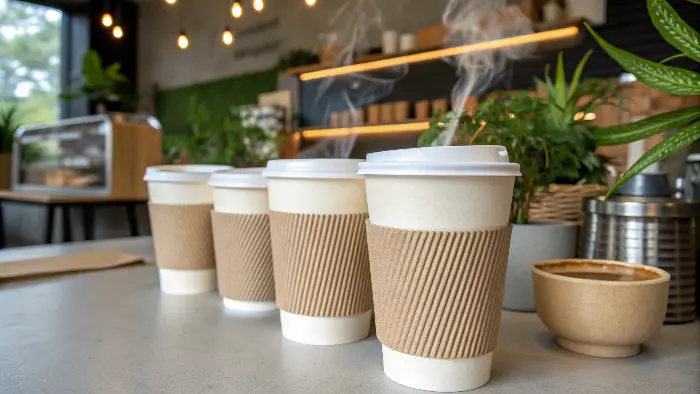
This is usually the first big switch cafes consider, and for good reason! Your coffee cup is like your cafe’s handshake – it’s the first tangible thing many customers interact with. Making it an eco-friendly one sends a powerful message. I’ve worked with numerous cafes, and the positive feedback they get after switching to biodegradable cups and lids is almost immediate. It’s like, phew, finally! But it’s important to understand what "biodegradable" and "compostable" really mean in this context.
Understanding "Biodegradable" vs. "Compostable"
This is super important, and something I clarify with clients like Jacky all the time. "Biodegradable" simply means a material can be broken down by microorganisms over time. But "time" is the tricky word – a plastic bag is technically biodegradable, but it might take centuries! "Compostable," on the other hand, means the material can break down into natural elements in a compost environment within a specific timeframe (usually a few months), leaving no toxic residue. For cups and lids, you’re typically looking for:
- PLA (Polylactic Acid)-lined paper cups: PLA is a bioplastic made from plant starch (like corn). It looks and feels like plastic but is commercially compostable.
- Bagasse cups and lids: Bagasse is the fibrous pulp left over after sugarcane processing. It’s a fantastic renewable resource, tree-free, and compostable. It’s sturdy and great for hot drinks too.
- CPLA (Crystallized Polylactic Acid) lids: Often used for hot cup lids, CPLA is a modified PLA that can withstand higher temperatures. Also commercially compostable.
It’s crucial to check for certifications like BPI (Biodegradable Products Institute) in North America or EN 13432 in Europe. These ensure the products meet specific compostability standards.The Catch: Proper Disposal
Here’s the kicker – most "compostable" coffee cups and lids need an industrial composting facility to break down properly. They require higher temperatures than a typical home compost bin can achieve. So, a key part of using these products is ensuring access to commercial composting services or, at the very least, educating customers on proper disposal. If they end up in landfill, they might not break down as intended and can even produce methane, a potent greenhouse gas. It’s not a magic bullet, but part of a system. We at Ecosourcecn always emphasize this "end-of-life" planning. It’s about the full circle! We once helped a small cafe chain set up a collection system for their compostable cups, partnering with a local composting facility. It was a bit of work initially, but totally worth it for their green credentials and customer appreciation.
Compostable Utensils and Straws: Sipping and Scooping Sustainably?
Beyond cups, those little plastic spoons and straws add up fast. Are compostable alternatives really a practical and eco-friendly solution for your cafe’s needs?
Absolutely! Compostable utensils (like CPLA or wood) and straws (paper, PLA, bamboo) offer a sustainable way to enjoy takeaway items without the lasting plastic pollution.
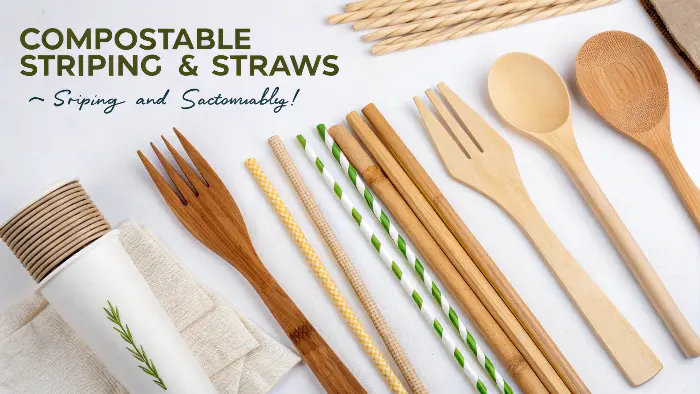
It’s those small things, isn’t it? A plastic straw used for 15 minutes can linger in the environment for 200 years. Crazy! When I talk to cafe owners, they often underestimate the impact of these "minor" items. But customers notice, especially the eco-aware ones. Switching to compostable cutlery and straws is another big tick in the sustainability box. Plus, there are some really stylish options out there now!
Material Matters: What Are Your Options?
Gone are the days when eco-friendly meant flimsy or unappealing. The market for compostable utensils and straws has exploded with innovation.
- Utensils:
- CPLA (Crystallized Polylactic Acid): This is a popular choice. CPLA cutlery is strong, heat-resistant (good for hot soups or stirring coffee), and commercially compostable. It often comes in white or black and looks quite sleek.
- Wood/Bamboo: A fantastic, natural option. Wooden or bamboo cutlery (spoons, forks, knives) is inherently biodegradable and often home compostable. It has a lovely, rustic feel. We source a lot of FSC-certified wooden cutlery for clients who want that truly natural vibe.
- Straws:
- Paper: The most common alternative. Modern paper straws are much better than they used to be – less prone to getting soggy quickly! They are widely recyclable and biodegradable.
- PLA: Clear, plastic-like straws made from plant starch. Commercially compostable. Good for cold drinks.
- Bamboo/Reusable: For a super-eco option, some cafes offer reusable bamboo straws or even sell them.
- Hay/Wheat Stem Straws: These are literally dried wheat stems – 100% natural and compostable. Pretty cool, huh?
Performance and Perception
One concern cafe owners sometimes have is performance. Will these eco-utensils break? Will the straws go mushy? My experience? Quality has improved dramatically. Reputable suppliers, like us at Ecosourcecn, ensure our products meet quality standards. Jacky, our Canadian packaging specialist contact, always tests samples rigorously for functionality – he knows his customers won’t compromise on the experience. And honestly, customers appreciate the effort. Offering a wooden spoon with a takeaway porridge pot or a paper straw with an iced latte signals that you care. It enhances the brand image. I remember a client telling me that after they switched to wooden stirrers and paper straws, their customer engagement on social media about their green initiatives actually went up! It’s a visible commitment. Small change, big message.
Recyclable Coffee Sleeves and Stirrers: Small Items, Big Impact?
Coffee sleeves protect hands, stirrers mix drinks. They seem minor, but can switching these to recyclable or eco-friendly versions truly make a difference in a cafe’s footprint?
Yes, definitely! Opting for recyclable cardboard sleeves and wooden or bamboo stirrers significantly reduces plastic waste and supports a circular economy. Small items add up!
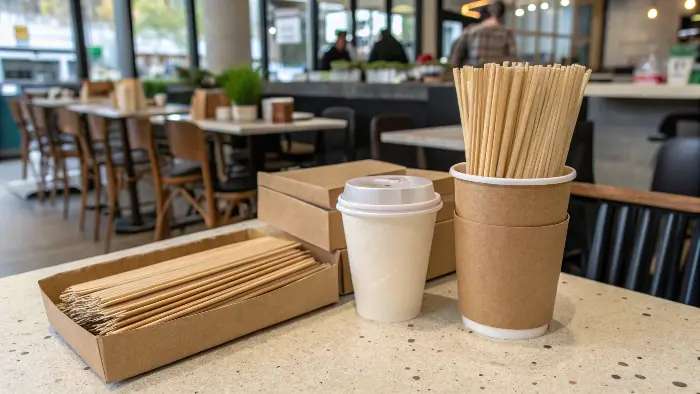
You know, it’s often the little things that get overlooked. A coffee sleeve, a stirrer – they’re used for moments, then discarded. But multiply that by hundreds of customers a day, and the waste becomes substantial. I always advise cafes to look at every single-use item. Switching these smaller accessories is often an easy win, both environmentally and for brand perception. It’s like finding loose change – it all adds up!
Sleeves: Recyclable and Brandable
Most coffee sleeves are made from cardboard, which is great because cardboard is widely recyclable! The key things to look for are:
- Recycled Content: Many sleeves are made with a high percentage of post-consumer recycled paper. This is a double win – diverts waste from landfill AND reduces the need for virgin pulp.
- FSC Certification: Forest Stewardship Council (FSC) certification ensures the paper comes from responsibly managed forests. This is something Jacky always looks for, and we make it a priority at Ecosourcecn.
- Minimal Inks/Adhesives: Simpler designs with eco-friendly inks are easier to recycle.
And hey, sleeves are prime real estate for branding! You can print your logo, a sustainability message, or even a QR code linking to your green initiatives. I’ve seen some really clever designs that enhance the customer experience while being eco-conscious. It’s a walking advertisement for your cafe’s values.Stirrers: Wood is Good!
Plastic stirrers are a real menace. They’re tiny, rarely recycled (they fall through sorting machinery), and end up polluting waterways. The best alternatives?
- Wood: Birchwood stirrers are fantastic. They are strong, smooth, biodegradable, and compostable (often even in home compost). They feel much nicer than flimsy plastic.
- Bamboo: Another excellent natural material. Bamboo is fast-growing, sustainable, and the stirrers are robust and compostable.
I was at a trade show recently, and the Ecosourcecn booth had samples of our wooden stirrers. People loved the natural feel. It’s a simple swap that just makes sense. Some might say, "It’s just a stirrer," but I say it’s an opportunity. An opportunity to ditch one more piece of unnecessary plastic. Every little bit helps paint that bigger, greener picture for your cafe.Packaging Options: Kraft Bags and Compostable Plates for Takeaway Treats?
Your delicious pastries and sandwiches need packaging too! Are kraft bags and compostable plates truly sustainable choices for cafe takeaway, or just greenwashing?
They are excellent sustainable choices! Kraft paper bags are recyclable and biodegradable, while compostable plates (like bagasse or PLA) reduce plastic significantly for food service.
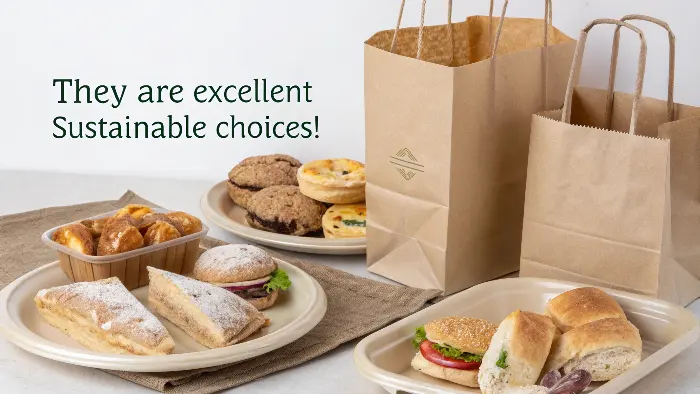
Takeaway food is a huge part of many cafes’ businesses, especially now. But all those plastic clamshells and styrofoam containers? Ugh, it’s a sustainability nightmare! I get excited when I see cafes embracing better alternatives because this is an area where we can make a massive dent in plastic waste. Think about it – every muffin, every sandwich, every slice of cake that goes out in eco-friendly packaging is a win.
Kraft Paper: The Humble Hero
Kraft paper is such a workhorse in the sustainable packaging world. Why is it so good?
- Recyclable & Biodegradable: It’s made from wood pulp and breaks down naturally. Unbleached kraft paper is even better as it uses fewer chemicals in production.
- Strong & Versatile: Great for bags for pastries, cookies, or even small lunch items. You can get flat bags, gusseted bags, bags with handles… so many options!
- Customizable: Kraft paper provides a lovely natural canvas for your cafe’s branding. A simple stamp or a printed logo looks fantastic. We often help clients design custom kraft packaging that reflects their brand’s earthy, wholesome vibe. It just feels more natural than shiny plastic.
I remember one bakery client who switched from plastic bags to custom-printed kraft bags. They said customers actually commented on how much nicer the packaging felt, and it made their artisanal products seem even more special.Plates and Containers: Beyond the Plastic Clamshell
For more substantial takeaway meals, or if you’re catering, ditching plastic or foam plates and containers is crucial. Here are some top-notch alternatives:
- Bagasse (Sugarcane): My personal favorite for plates and clamshells! Bagasse is strong, grease-resistant, microwaveable, and compostable (industrially, sometimes at home for smaller, uncoated items). It’s made from a waste product, which is brilliant.
- PLA-lined Paperboard: For boxes or trays that need to be moisture-resistant. The PLA lining makes them compostable in industrial facilities.
- Molded Fiber: Similar to bagasse, often made from recycled paper pulp or other plant fibers.
These options are not only better for the planet but also often look and feel more premium than their plastic counterparts. Jacky, our Canadian contact, is always keen on finding robust bagasse containers that can handle saucy dishes without leaking – and they exist! It’s about finding the right product for the right application.Reducing Landfill Waste: What’s the Real Payoff of Going Green?
Switching to eco-friendly supplies sounds good, but what’s the actual, tangible benefit in terms of reducing landfill waste for a cafe? Is it significant?
The payoff is huge! Eco-friendly supplies drastically cut down the volume of non-biodegradable waste a cafe sends to landfill, lessening environmental strain and sometimes even disposal costs.
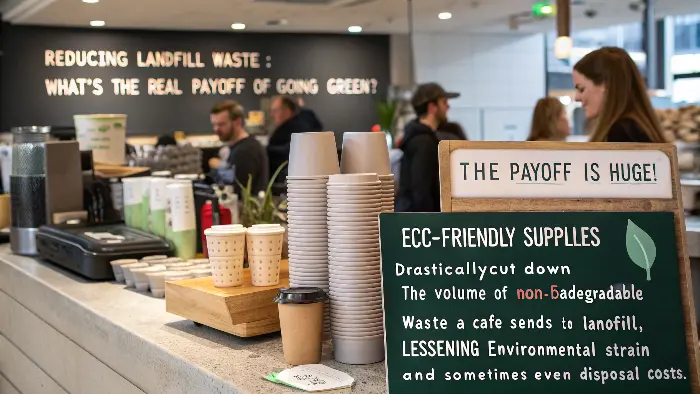
This is where the rubber meets the road, or rather, where the waste doesn’t meet the landfill! I’ve seen the numbers, and they can be pretty dramatic. Think about a typical cafe’s bin at the end of the day – overflowing with plastic-lined cups, plastic lids, stirrers, cutlery, and containers. Now imagine a significant portion of that being diverted from landfill because it’s compostable or truly recyclable. That’s a massive win.
The Tangible Reduction
Let’s break it down. A busy cafe might use several hundred cups, lids, and other items daily.
- Traditional Scenario: Almost 100% of single-use plastic items go to landfill. Even if some paper cups are "recyclable," the plastic lining often means they end up in landfill anyway, or their recycling is very specialized and not widely available.
- Eco-Friendly Scenario:
- Compostable cups, lids, cutlery, and food containers (PLA, bagasse, wood) can be diverted to industrial composting. This turns waste into valuable soil conditioner!
- Recyclable cardboard sleeves and truly recyclable paper items (like some paper straws or unlined kraft bags) can go into the paper recycling stream.
- The volume of actual trash heading to landfill plummets. I worked with a client who tracked their waste volume before and after switching. They reduced their general waste bin collections by almost half! That’s not just an environmental win; it can also mean lower waste disposal fees depending on your local services.
More Than Just Volume: The Quality of Waste
It’s not just about how much waste, but what kind of waste. Landfills are not benign entities. As organic waste (like food scraps mixed with plastic) decomposes anaerobically (without oxygen), it produces methane, a greenhouse gas over 25 times more potent than carbon dioxide over a 100-year period. By separating out compostable materials, you’re not only reducing landfill volume but also mitigating methane emissions. Furthermore, plastic in landfills leaches harmful chemicals into the soil and groundwater for centuries. By choosing materials designed to break down benignly or be recycled, you’re actively preventing this long-term pollution. Jacky often emphasizes this to his team – it’s about responsible material stewardship from cradle to grave, or ideally, cradle to cradle (circular economy). It’s a powerful story to tell your customers too!
Attracting Eco-Conscious Customers: Does Going Green Really Boost Business?
We all want to do good, but cafes are businesses. So, does investing in eco-friendly supplies genuinely translate into more customers and a stronger bottom line?
Absolutely, yes! Consumers are increasingly choosing businesses that align with their values. Visible eco-friendly practices attract and retain customers, building loyalty and positive brand perception.
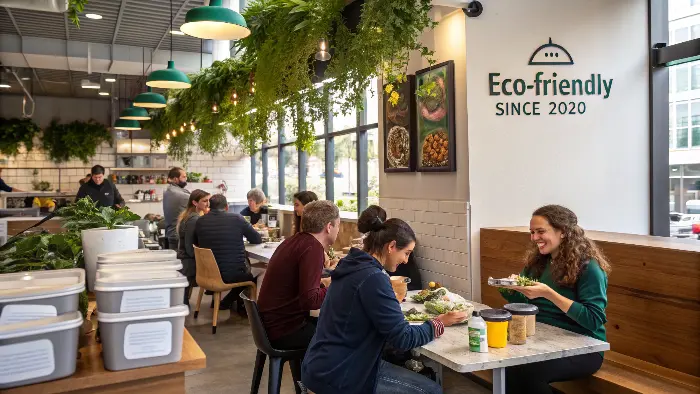
I’ve seen this firsthand so many times it’s not even a question for me anymore. In today’s world, especially with younger generations like Millennials and Gen Z, sustainability isn’t just a "nice-to-have"; it’s an expectation. They vote with their wallets! If your cafe visibly demonstrates a commitment to the environment, you’re speaking their language. This is a point I often discuss with clients at Ecosourcecn – going green is a powerful marketing tool.
The "Green" Consumer is Growing
Study after study shows that consumers are willing to pay more for sustainable products and support businesses that are environmentally responsible.
- Differentiation: In a crowded market, being the "eco-cafe" can be a significant differentiator. It gives people a reason to choose you over a competitor who isn’t making the same effort.
- Brand Loyalty: When customers see you’re making an effort (e.g., compostable cups, clear recycling bins, signage about your initiatives), it builds trust and loyalty. They feel good about supporting you. I know I personally seek out cafes that use sustainable packaging.
- Word-of-Mouth & Social Media: Happy, eco-conscious customers love to share! They’ll tell their friends, post on social media about your cool wooden cutlery or your compostable cups. It’s organic marketing gold! I remember a cafe owner telling me their Instagram engagement spiked when they posted about their new bagasse takeaway containers. People genuinely get excited about this stuff.
Beyond Just Supplies: Building a Green Brand Story
It’s not just about the products themselves, but the story you tell. Action Customer Perception Potential Impact Using compostable cups/lids "They care about reducing plastic waste." Increased preference, positive reviews. Offering wooden stirrers/cutlery "This feels natural and high-quality." Enhanced sensory experience, shareable moment. Clear signage about recycling/composting "They are transparent and making it easy for me." Builds trust, encourages correct disposal. Sourcing local/organic ingredients "They support the community and healthy choices." Attracts health-conscious and ethical consumers. Partnering with eco-suppliers (like Ecosourcecn!) "They are serious about their supply chain." Boosts credibility, appeals to B2B if applicable. Jacky, with his background in environmental science, knows this. His brand in Canada thrives on its eco-conscious image. It’s not just a trend; it’s a fundamental shift in consumer behavior. Investing in eco-friendly supplies is investing in your cafe’s future and its connection with the community. It’s a win-win! 🔥
Eco-Friendly Coffee Shop Supplies: A Sustainable Choice Beyond Just Products?
Okay, so we’ve covered cups, lids, and straws. But is being truly sustainable about more than just the individual items? What’s the bigger picture for a cafe?
Yes, it’s about a holistic approach: choosing certified products, partnering with ethical suppliers, educating staff and customers, and continuously seeking ways to minimize overall environmental impact.
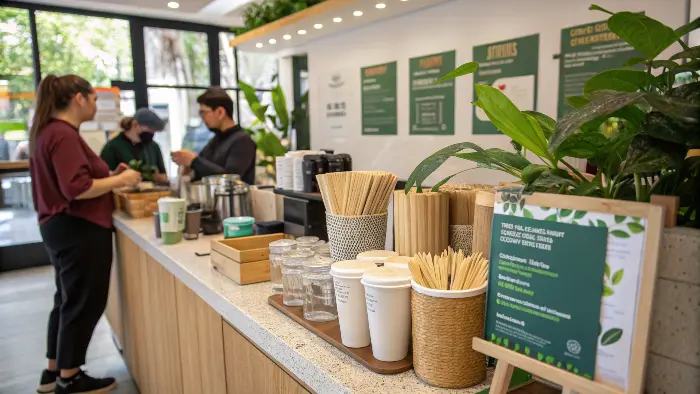
This is where it all comes together, you know? It’s easy to swap out a plastic cup for a compostable one and call it a day. But truly embracing sustainability in your cafe goes deeper. It’s about building an entire ecosystem of responsible choices. At Ecosourcecn, we try to be more than just a supplier; we aim to be partners in that journey. It’s a mindset shift that can transform your business.
The Importance of Partnerships and Certifications
Choosing the right supplier is key. You want someone who understands the materials, the certifications, and your vision.
- Supplier Ethics: Does your supplier prioritize sustainability in their own operations? Are they transparent about their sourcing? (We certainly try to be!)
- Certifications: We’ve mentioned BPI, EN 13432, FSC – these aren’t just fancy labels. They are third-party verifications that products meet specific environmental standards. For someone like Jacky, who needs to ensure compliance for his Canadian brand, these certifications are non-negotiable. They provide assurance that you’re not accidentally "greenwashing."
- Product Knowledge: A good supplier can guide you through the options – PLA vs. bagasse, home compostable vs. industrial. They can help you find the best fit for your specific needs and local waste infrastructure. I’ve had long chats with cafe owners just brainstorming the best solutions for their unique setup.
Beyond Products: Operational Changes and Education
Sustainability also involves looking at your cafe’s operations:
- Waste Management: Implementing proper sorting bins for compost, recycling, and landfill is crucial. And train your staff on what goes where!
- Customer Education: Simple signage can go a long way. Explain why you’ve chosen certain packaging and how customers can dispose of it correctly. Maybe offer a small discount for bringing a reusable cup?
- Energy and Water Efficiency: Look at your appliances, lighting, and water usage. Small changes here can add up.
- Sourcing Locally: If possible, sourcing coffee beans, milk, and food ingredients locally reduces your carbon footprint from transportation.
It’s about creating a culture of sustainability within your cafe. When your staff are on board and your customers understand your efforts, it creates a really positive ripple effect. It’s not just about buying "green stuff"; it’s about being green in your actions and ethos. That’s the global impact we believe in.Conclusion
Switching to eco-friendly accessories isn’t just a trend; it’s a smart, responsible business decision. It reduces waste, attracts customers, and genuinely helps our planet.


